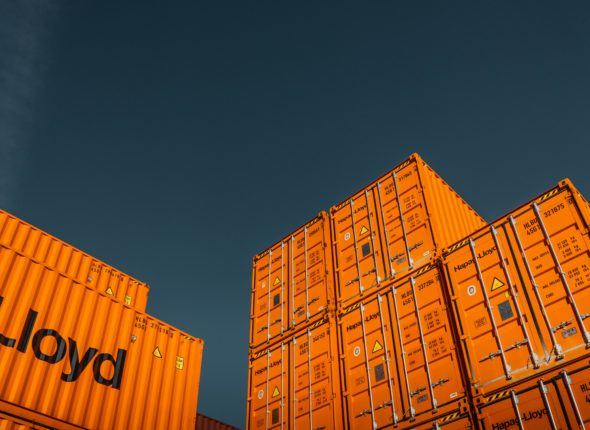Disruptive market developments are exerting pressure on grocery retail supply chains. In a series of blog posts, we will investigate these trends, explain their impact on the supply chain and show how grocery retailers can build a future-proof supply chain.
Changing customer and store requirements as well as an increase in digital sales channels are putting pressure on end-to-end supply chains of full assortment grocery retailers. Current grocery retail supply chains were designed as much as 70 years ago, based on the handling and throughput of large volumes. Today, this foundation is shifting rapidly towards much smaller delivery quantities, reduced response times, and more frequent delivery. It is essential for supply chain managers to exactly understand how these disruptive market developments impact their supply chain and what needs to be done to keep meeting the increasing demands on the supply chain in the future. This blog post explains the current market developments and highlights the three guiding principles for future-proof grocery retail supply chains.
Five Trends Are Shaping the Grocery Retail Industry
In the past, supermarkets used to be planned with similar sizes and attributes, following the principle of a “standard” supermarket. Often, they were built close to rural development areas with sufficient space and parking possibilities for family shoppers. The corresponding supply chain setup focused on the handling and throughput of large volumes. In the last few years, we have observed five major trends that are increasingly challenging this traditional picture:
- Demography: The average household size in Europe is declining, with now on average 2.3 persons per household versus 2.8 in 1980.[1] Single-person households in particular saw an increase of 18.7% between 2010 and 2019, whereas households with children decreased by 10.8%.[2] That means demand is changing towards smaller package sizes or fewer packages per customer, a smaller overall shopping basket, as well as more pre-prepared meals with limited shelf life.
- Urbanization: In Europe, the number of people living in cities is expected to grow towards 83.7% by 2050. With increasing urbanization, space in cities is becoming more scarce and disproportionately expensive, making it difficult to find adequate space for conventional supermarkets. Furthermore, mobility is changing. For example, in Paris less than 10% of the population own a car. Therefore, people are losing the ability to transport bigger shopping baskets over a larger distance.[3]
- Customer expectations: New digital offerings such as Amazon Fresh and Amazon Pantry add to customer choice on the one hand and increase their expectations of shipment offerings on the other hand. Customers demand real-time transparency, including for product availability. Going forward, there is a need for personalization (“segment of one”), while at the same time the customer expects a consistent experience along all touchpoints.
- Product lifecycles: Technological advancements have made it much easier to undertake new product launches. New marketing tools combine signals from diverse marketing channels (e.g. Instagram, eCoupons, Twitter), bringing together a broad customer audience. This information then gets transformed rapidly through marketing into specific product offerings. On the one hand, this leads to “pop-up” products: products with an extremely short lifecycle, sometimes as little as a couple of weeks. On the other hand, we can see products customized to local demand that go on sale only in specific areas
- Direct-to-consumer: Fast-moving consumer goods manufacturers are connecting directly with consumers in order to provide a unique customer experience, collect actionable data about consumer behavior, and get direct responses to product changes or new product launches. Platforms such as Bringg or Onfleet allow them to offer fit-for-purpose last-mile deliveries through third parties and customer data collection. This exerts heavy pressure on existing retail supply chains.
How Are Grocery Retailers Responding to the New Situation?
We mainly see two strategic responses from full-assortment grocery retailers to the new market trends: convenience stores and e-commerce. Both have a fundamental impact on the supply chain.
Convenience stores
Convenience stores need rather little space, averaging 100 m2, while conventional mid-sized supermarkets operate on around 1,200 m2. They are typically positioned much closer to their customers, mainly in densely populated areas serving the daily needs of their neighborhood and being accessible by foot. A typical convenience store operates between 1,200 and 2,500 SKUs (mid-sized supermarkets have around 12,000), leading to a comparably higher number of SKUs per m2. For the supply chain, an increase in smaller stores means more points of delivery with less demand per SKU. This could lead to issues of shelf life and shelf space when sending standard minimum order quantities (e.g. full box). Furthermore, these small stores have special delivery requirements as they are in many cases not reachable by bigger trucks and have limited capacity for shelf refilling and backroom space if supply peaks occur.
E-commerce
E-commerce is expected to grow by 66% in Europe in the five years leading up to 2023, not taking into consideration the Covid-19 lockdowns and the resulting boost in online shopping.[4] In basic terms, two key types can be distinguished:
- Delivery from store or store pickups allow for rapid geographical expansion as the existing store network can be utilized without a need for huge investments. On the downside, the threat of stockouts is larger as the purchase and picking of goods is time independent, leading to frustrated customers. Furthermore, stores are not created for efficient online picking, but for the shopper experience, which compromises operational efficiency.
- Dedicated fulfillment centers are built especially for e-commerce. Dedicated pickers or automated processes ensure smooth and efficient product handling in non-public, picking-optimized so-called “dark stores”. In order to cover the usually massive investments in hard- and software, a sufficient sales threshold needs to be reached.
- A hybrid of these two types is the third option. In certain stores, we can see that part of the space is detached and used as a dark store. In these areas, products with a high turnover dominate. Articles in these areas may be picked manually or even automatically. In any case, there is an efficiency increase with in-store operations for e-commerce articles in these areas. Problems with stockouts for articles outside this area remain. Furthermore, sufficient space is a prerequisite to provide such an area.
One of the biggest challenges for e-commerce in the end-to-end supply chain is how to deal with stockouts. Typically, retailers initiate e-commerce with deliveries from stores. From our perspective, in-store stockouts are not acceptable for e-commerce customers. Sooner or later customer expectations will lead to the need to open a dark store. In contrast to brick & mortar sales channels, it is challenging to steer customer demand, as e-commerce does not have tools such as positioning or dynamic price reductions (for end of shelf life). Hence new ways need to be found to sell off excess stock online. Short shelf-life products such as dairy are otherwise at constant risk of being thrown away in dark stores.
We have seen how grocery retailers are responding to the new market developments and how this impacts their supply chain. In our next blog post, we will take a look at the future and explain the prerequisites and key guiding principles of a future-proof grocery retail supply chain.
We would like to thank Alexandros Anagnostopoulos, Warehousing Director at AB Vassilopoulos, a brand of Ahold Delhaize, for his valuable contribution to this article.
[2] https://ec.europa.eu/eurostat/statistics-explained/index.php/Household_composition_statistics
This post is the first part of our blog series on how to build a future-proof grocery retail supply chain. Further parts of the series:
Part 2: The Three Principles of Future-Proof Grocery Retail Supply Chains
Part 3: Grocery Retail: How to Align the Supply Chain towards Market Demands
Part 4: Boosting Sales Performance in Grocery Retail Supply Chains
Part 5: Setting the Table: Designing a Supply Chain Network in Grocery Retail

